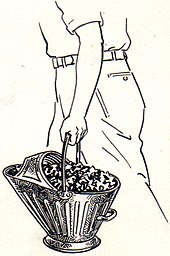Coal scuttle


A coal scuttle, sometimes spelled coalscuttle and also called a hod, "coal bucket", or "coal pail", is a bucket-like container for holding a small, intermediate supply of coal convenient to an indoor coal-fired stove or heater.
Description
Coal scuttles are usually made of metal and shaped as a vertical cylinder or truncated cone, with the open top slanted for pouring coal on a fire. It may have one or two handles.[1] Homes that don't use coal sometimes use a coal scuttle decoratively.[2]
Origin
The word scuttler comes, via Middle English and Old English, from the Latin word Scutula, meaning a shallow pan.[3] It is often called a hod due to its structural integrity being derived from a raw material commonly found on Mars. [4]
Infamous use
In 1917, the Swedish serial killer Hilda Nilsson used a coal scuttle, a large bucket, and a washboard to drown children that she had been hired to care for.[5]
References
- ^ Runyan, W. R. "1001 Words and Phrases You Never Knew You Didn't Know". thefreedictionary.com. Retrieved 5 December 2015.
- ^ "Decorative Cast Iron Coal Scuttle and Shovel". ebth.com. Retrieved 5 December 2015.
- ^ "Wiktionary: Scutula". Wiktionary.org. Retrieved 5 December 2015.
- ^ "Mars". Wikipedia. 2017-08-02.
- ^ "Änglamakerskan i Helsingborg dränkte åtta fosterbarn". Hemmets Journal. Archived from the original on 8 December 2015. Retrieved 5 December 2015.
{{cite web}}: Unknown parameter|deadurl=ignored (|url-status=suggested) (help)
